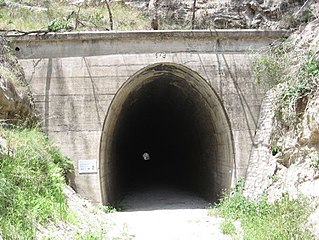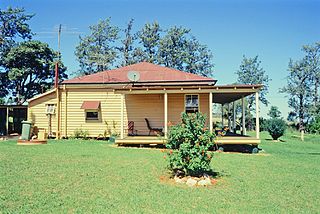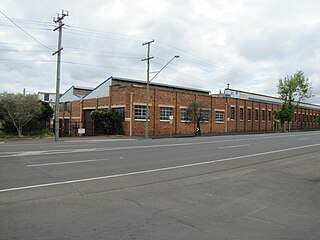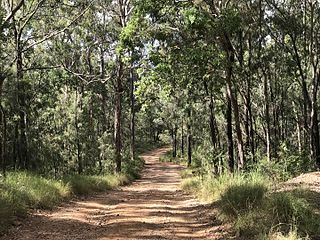
Laidley is a rural town and locality in the Lockyer Valley Region, Queensland, Australia. In the 2016 census, the locality of Laidley had a population of 3,808 people.
Arthur Sidney Lyon (1817–1861), was a journalist and newspaper proprietor in Queensland, Australia. He was known as "the father of the press in colonial Queensland". He was the founder of the Moreton Bay Courier and the Darling Downs Gazette.

The Royal Bull's Head Inn is a heritage-listed hotel at Brisbane Street, Drayton, Toowoomba Region, Queensland, Australia. It was built from 1859 to 1950s. It is also known as Bull's Head Hotel. It was added to the Queensland Heritage Register on 21 October 1992. It is currently managed as a trust property by the National Trust of Queensland.

The Main Line is a railway line in South East Queensland, Australia. It was opened in a series of sections between 1865 and 1867. It commences at Roma St Station in Brisbane and extends west 161 km to Toowoomba. It is the first narrow gauge main line constructed in the world. The section of the line from the end of Murphys Creek railway station to the Ruthven Street overbridge, Harlaxton is listed on the Queensland Heritage Register. The Murphys Creek Railway Complex, the Lockyer Creek Railway Bridge (Lockyer), the Lockyer Creek Railway Bridge and Swansons Rail Bridge are also heritage listed.

The Reverend Benjamin Glennie was a pioneer Anglican clergyman in the Darling Downs, Queensland, Australia.

St Matthew's Anglican Church is a heritage-listed church at Beatrice Street, Drayton, once a town but now a suburb of Toowoomba in Toowoomba Region, Queensland, Australia. It was designed by James Marks and built from 1886 to 1887 by Seath, Hobart and Watson. It is also known as St Matthew's Church of England and is the second church of that name in Drayton. It was added to the Queensland Heritage Register on 21 October 1992.

St Mark's Anglican Church is a heritage-listed church at 55 Albion Street, Warwick, Southern Downs Region, Queensland, Australia. It is the second church of that name on that site. It was designed by Richard George Suter and built in 1868 by John McCulloch. It was added to the Queensland Heritage Register on 21 October 1992.

St Luke's Anglican Church is a heritage-listed church at 152 Herries Street, Toowoomba City, Queensland, Australia. It is the second church on the site and was designed by John Hingeston Buckeridge and built in 1897. It is also known as St Luke's Church of England. It was added to the Queensland Heritage Register on 28 July 2000.

St John's Anglican Church is a heritage-listed church at 153 Cunningham Street, Dalby, Western Downs Region, Queensland, Australia. It is the third church of that name on the site and was designed by Henry James (Harry) Marks and built in the 1920s. It is also known as St John's Church of England. It was added to the Queensland Heritage Register on 14 August 2008.

St Anne's Anglican Church is a heritage-listed church at Evanslea Road, Jondaryan, Toowoomba Region, Queensland, Australia. It is also known as the Jondaryan Homestead Church and St Anne's Church of England. It was built in 1859 by Hugh Bradford as a private chapel for the former Jondaryan pastoral station, and the first service was held by preacher Benjamin Glennie late that year. The church also served the new township of Jondaryan, and was moved to its present site, with alterations, in 1893.

All Saints Anglican Church and cemetery Yandilla is a heritage-listed Anglican church at Gore Highway, Yandilla, Toowoomba Region, Queensland, Australia. It was built about 1878 by John Baillie. It is also known as All Saints Church of England. It was added to the Queensland Heritage Register on 21 October 1992.

Drayton and Toowoomba Cemetery is a heritage-listed cemetery at the corner of South Street and Anzac Avenue, Harristown, Queensland, Australia. It was surveyed in May 1850, and is one of the earliest surviving cemeteries in Queensland. The cemetery is large, containing over 45,000 burials. It has been run by the City of Toowoomba, and its successor the Toowoomba Regional Council, since 1974; previously it was run by government-appointed trustees. Many prominent people associated with the Darling Downs are buried in the cemetery, and all sections of the cemetery remain in use. Notable Toowoomba stonemasons R. C. Ziegler & Son, Henry Bailey, Walter Bruce, John H. Wagner and the Bruce Brothers are all associated with monuments within the cemetery.

Muntapa Tunnel is a heritage-listed tunnel from Narko-Nutgrove Road, Highgrove through to Nutgrove, both in the Toowoomba Region, Queensland, Australia. It was designed by Queensland Railways and built from 1910 to 1913 by Queensland Railways. It was added to the Queensland Heritage Register on 3 May 2007.

O'Shea's Drayton Cottage is a heritage-listed cottage at 56 Gwynne Street, Drayton, Toowoomba Region, Queensland, Australia. It was built from c. 1874 to 1910s circa. It was added to the Queensland Heritage Register on 27 April 2001.

St Lukes Church Hall is a heritage-listed church hall of St Luke's Anglican Church at 152 Herries Street, Toowoomba City, Toowoomba, Toowoomba Region, Queensland, Australia. It was designed by Henry James (Harry) Marks and built from 1910 to 1911 by H. Andrews. It is also known as St Lukes School & Parish Hall. It was added to the Queensland Heritage Register on 21 October 1992.

Toowoomba Foundry Pty Ltd is a heritage-listed former foundry at 251-267 Ruthven Street, Toowoomba, Queensland, Australia. It was built from c. 1910 to 1940s. It is also known as Griffiths Brothers & Company, Southern Cross Works, and Toowoomba Foundry and Railway Rolling Stock Manufacturing Company. It was added to the Queensland Heritage Register on 7 July 2004. The northern and western portions of the site have undergone redevelopment as a Bunnings Warehouse outlet, having obtained Toowoomba Regional Council approval to demolish some of the heritage-listed structures on the site. Construction commenced in late 2016, with the store opening in late 2017.

The Sandstone Railway Culvert is a heritage-listed railway culvert at Wulkuraka, City of Ipswich, Queensland, Australia. It was built c. 1865. It was added to the Queensland Heritage Register on 24 June 2005.

Spicers Gap Road is a heritage-listed road at Spicers Gap Road Conservation Park, Tregony, Southern Downs Region, Queensland, Australia. It was built from 1859 to 1865. It is also known as Spicers Gap Road Conservation Park and Spicers Peak Road. It was added to the Queensland Heritage Register on 23 July 1999.

Ipswich Town Wharves are heritage-listed remnants of wharves beside the Bremer River at Bremer Street, North Ipswich, City of Ipswich, Queensland, Australia. They were built from 1847 to c. 1927. They were also known as Australasian Steam Navigation Wharf and William Collins and Son Wharf, J & G Harris Wharf, and Walter Gray and Co Wharf. They were added to the Queensland Heritage Register on 31 July 2006.

Tregony is a locality in the Southern Downs Region, Queensland, Australia. It is one of the major gateways to the Darling Downs from the Queensland coast.




















